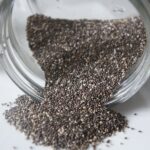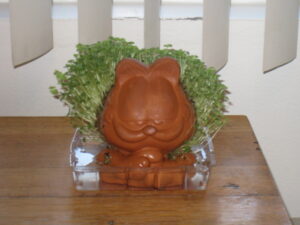Chia Seeds Can Increase Fiber
go.ncsu.edu/readext?1031627
en Español / em Português
El inglés es el idioma de control de esta página. En la medida en que haya algún conflicto entre la traducción al inglés y la traducción, el inglés prevalece.
Al hacer clic en el enlace de traducción se activa un servicio de traducción gratuito para convertir la página al español. Al igual que con cualquier traducción por Internet, la conversión no es sensible al contexto y puede que no traduzca el texto en su significado original. NC State Extension no garantiza la exactitud del texto traducido. Por favor, tenga en cuenta que algunas aplicaciones y/o servicios pueden no funcionar como se espera cuando se traducen.
Português
Inglês é o idioma de controle desta página. Na medida que haja algum conflito entre o texto original em Inglês e a tradução, o Inglês prevalece.
Ao clicar no link de tradução, um serviço gratuito de tradução será ativado para converter a página para o Português. Como em qualquer tradução pela internet, a conversão não é sensivel ao contexto e pode não ocorrer a tradução para o significado orginal. O serviço de Extensão da Carolina do Norte (NC State Extension) não garante a exatidão do texto traduzido. Por favor, observe que algumas funções ou serviços podem não funcionar como esperado após a tradução.
English
English is the controlling language of this page. To the extent there is any conflict between the English text and the translation, English controls.
Clicking on the translation link activates a free translation service to convert the page to Spanish. As with any Internet translation, the conversion is not context-sensitive and may not translate the text to its original meaning. NC State Extension does not guarantee the accuracy of the translated text. Please note that some applications and/or services may not function as expected when translated.
Collapse ▲In last week’s column I wrote about fiber in your diet.  One of the ways listed to increase fiber in your diet was to add seeds into your meals. Chia seeds are frequently suggested as a seed to try. This got me interested in learning more about these tiny seeds that some folks are calling a superfood.
One of the ways listed to increase fiber in your diet was to add seeds into your meals. Chia seeds are frequently suggested as a seed to try. This got me interested in learning more about these tiny seeds that some folks are calling a superfood.
These seeds can be brown, white or gray in color and are grown in South and Central America and Australia. Chia seeds are a rich source of healthy fat, protein and several minerals as well as antioxidants. Chia seeds are also high in insoluble fiber.
Chia seeds are mild tasting and soften easily in liquid. They are easy to digest and can be eaten whole, but studies have shown that ground seeds offer more nutritional benefits. They can be eaten dry or wet. When you add them to a liquid and allow to soak for 30 minutes the seeds swell up and form a gel that is similar to tapioca. This is the insoluble fiber at work.
Chia seeds can easily be found in most grocery stores. Look for them in either the baking aisle or by the produce. They are usually sold in large bags and can seem pricey, but a little can go a long way. They have a long shelf life of around 18 months if you store them in a cool, dark location. This storage time can be extended by refrigerating or freezing.
They are often used in smoothies, but can also be added to yogurt or oatmeal or
sprinkled on salads. Chia seeds can also be used as a substitute for eggs when baking. Recently in our Extension test kitchen we used them as a thickener in a lower sugar blueberry jam. Worth experimenting.
Here’s a recipe for a simple pudding made with chia seeds from the Eat Smart Move
More program at the Virginia Cooperative Extension. Plant-based milks such as soy,
almond or oat can be used instead of diary milk if you like. Use your favorite fruit—any
will work. You can also top it with granola, coconut flakes, slivered or chopped nuts.
Because of the chia seeds, one serving of this pudding gives you half of the
recommended amount of dietary fiber you need every day.
Chocolate Chia Pudding
- 1/4 cup cocoa powder
- 1 1/2 Tablespoons honey
- 1/2 teaspoon ground cinnamon

- 1/8 teaspoon salt
- 1/2 teaspoon vanilla extract
- 1 1/2 cups 1% milk
- 1/2 cup chia seeds
- 1 1/2 cups fruit
In a mixing bowl, add cocoa powder, honey, cinnamon, salt, and vanilla and whisk to
combine. NOTE: Sifting the cocoa powder before adding to the mixing bowl may help to reduce clumps. Pour a small amount of milk to the mixing bowl until a paste forms. Then, add remaining milk and whisk until smooth. Add chia seeds and whisk once more to combine. Refrigerate for at least 3 hours. Pudding will thicken as the seeds absorb the moisture. To serve, evenly spoon the pudding into serving containers. Top with fruit of your choice.
Makes 4 servings. Each serving contains 250 calories, 15 grams of dietary fiber and 14 grams of total sugars.
Another quick note: you may wonder if these seeds that are the same as those used to make “chia pets”? Remember those gifts for the person-who-has-everything?  Several years ago, I reached out to the folks that make “chia pets” and found out that YES, the chia seed that we’re hearing about as a food is the same plant that they use to grow green “fur” on these pottery animals. This crop of “hair” is the chia seed sprouting. But use caution, they were quick to tell me to NOT eat the seeds or sprouts that come with the chia pets. It seems that the food product seeds are grown and tested differently than those that are developed for the chia “pottery that grows” market.
Several years ago, I reached out to the folks that make “chia pets” and found out that YES, the chia seed that we’re hearing about as a food is the same plant that they use to grow green “fur” on these pottery animals. This crop of “hair” is the chia seed sprouting. But use caution, they were quick to tell me to NOT eat the seeds or sprouts that come with the chia pets. It seems that the food product seeds are grown and tested differently than those that are developed for the chia “pottery that grows” market.
Source: Eat Smart Move More, Arizona Cooperative Extension, NC
Cooperative Extension, Burke County Center and Michigan State University Cooperative
Extension
Syracuse is a Family and Consumer Science team member and can be reached at N.C. Cooperative Extension, Brunswick County Center 910-253-2610 or by email at
clsyracu@ncsu.edu



